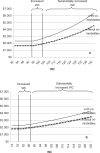Economic costs of abdominal obesity
- PMID: 20054174
- PMCID: PMC6452114
- DOI: 10.1159/000137822
Economic costs of abdominal obesity
Abstract
Background: To examine the relationship between waist circumference and future health care costs across a broad range of waist circumference values based on individual level data.
Method: A prospective cohort of 31,840 subjects aged 50-64 years at baseline had health status, lifestyle and socio-economic aspects assessed at entry. Individual data on health care consumption and associated costs were extracted from registers for the subsequent 7 years. Participants were stratified by presence of chronic disease at entry.
Results: Increased waist circumference at baseline was associated with higher future health care costs. For increased and substantially increased waist circumference health care costs rise at a rate of 1.25% in women and 2.08% in men, per added centimetre above normal waistline. Thus, as an example, a woman with a waistline of 95 cm and without co-morbidities can be expected to incur an added future cost of approximately USD 397.- per annum compared to a woman in the normal waist circumference group, corresponding to 22% higher health care costs.
Conclusions: Future health care costs are higher for persons who have an increased waist circumference, which suggests that there may be a potential for significant resource savings through prevention of abdominal obesity.
Copyright 2008 S. Karger AG, Basel.
Figures
References
-
- WHO: Obesity: preventing and managing the global epidemic Report of a WHO consultation. World Health Organ Tech Rep Ser. 2000;894:i–xii–1. - PubMed
-
- Haslam DW, James WPT. Obesity. Lancet. 2005;366:1197–1209. - PubMed
-
- Finkelstein EAFiebelkorn IC, Wang G. National medical spending attributable to overweight and obesity: how muchand who’s paying? Health Aff (Millwood) 2003 Suppl Web Exclusives(Millwood 2003 Jan-Jun Suppl Web Exclusives):W3–219. - PubMed
-
- Finkelstein EA, Fiebelkorn IC, Wang G. State-level estimates of annual medical expenditures attributable to obesity. Obes Res. 2004;12:18–24. - PubMed
-
- Andreyeva TSturm R, Ringel JS. Moderate and severe obesity have large differences in health care costs. Obes Res. 2004;12:1936–1943. - PubMed
Publication types
MeSH terms
LinkOut - more resources
Full Text Sources


